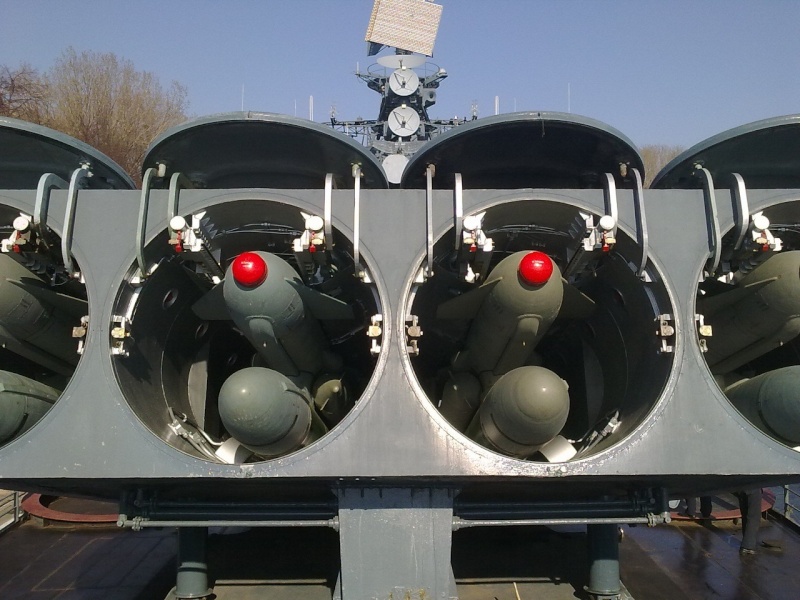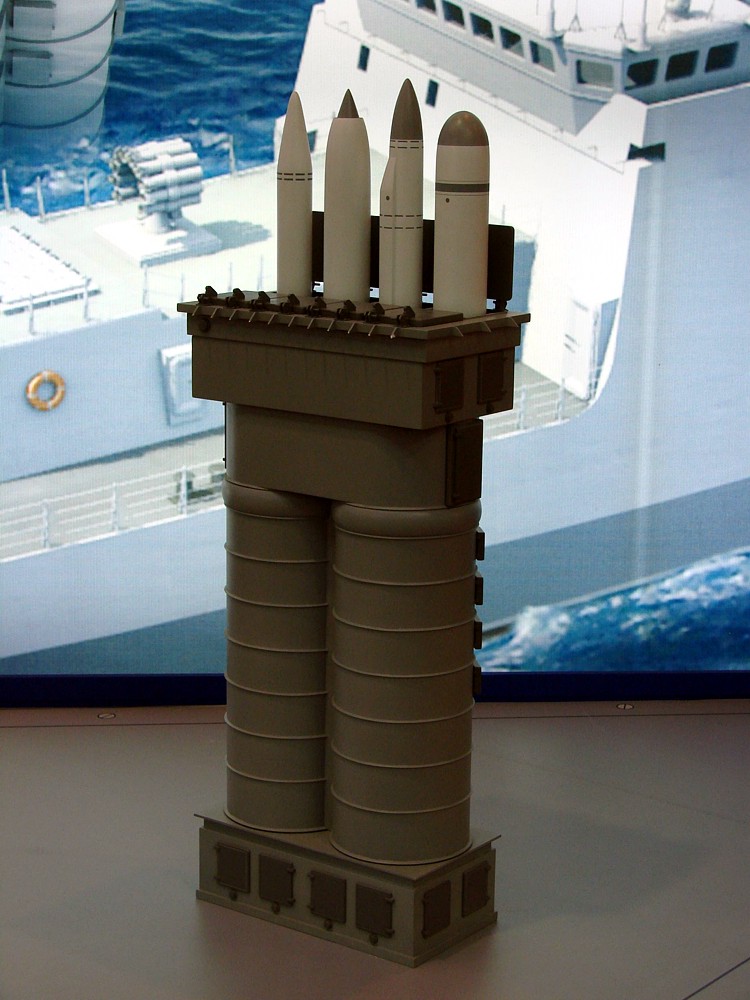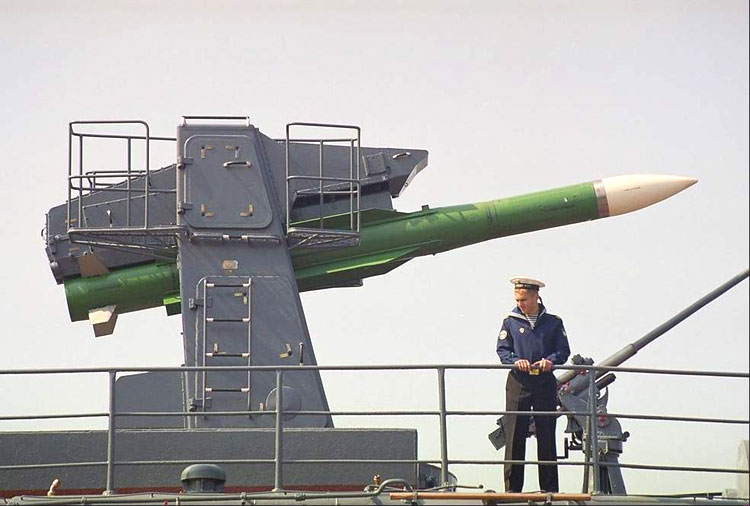Project 1135 Burevestnik -Krivak class
Frigate
Project #1135 Burevestnik [Krivak I] was an entirely new design, initially believed in the West to be designed for offensive surface warfare. In reality, the class was intended primarily as a defensive ASW ship. The Krivak was designed as a less expensive and capable counterpart to the larger Kresta II and Kara classes, with which it originally shared the BPK designation. In the late 1970s, the designation changed to SKR (Storozhevoy Koabl') or small antisubmarine ship, a more accurate indication of their actual capabilities.
The first of the 'Krivak' anti-submarine ships appeared in 1970. They were faster and more heavily armed than their Weastern counterparts, with four large SSN-14 Silex missiles. The huge quadruple SSN-14 launcher dominates the forward end of these ships. Twenty one ships were built before the first of the 11 improved 'Krivak IIs' appeared in 1976. This version had new guns and a larger variable depth sonar. The 'Krivak III' which entered service in the mid-1980s, dropped the Silex launcher for a sinlge gun turret and incorporated a hanger and flight deck instead of the stern gun turrets.
Of the 32 Krivak's that were constructed in the 1970s and early 1980s only 6 remained in the Russian Navy in 2005. As of 2008 IISS reported that two Krivak I and two Krivak II remained in service. It was anticipated that the others would be decommissioned within the following few years.
Project 1135 Krivak I Burevestnik
Sources all agree that the Krivak I series consisted of 19 units with the first unit being completed in 1970, though there is a diversity of views as to whether the final unit was completed in 1980 or 1982. And while there is agreement on the names of these units, there is rather profound diversity of opinion on the construction chronology [to the extent that some sources suggest that the Poryvisty was one of the earlier ships, completed in 1974, while others contend that is was the last ship, completed in 1982].
At least two and possibly three Krivak-I frigates were modernized between 1987 and 1994. Known in the West as MOD Krivak, different sources suggest that the Soviet designation was either Project #1135.2 Mod or Project #1135.6 [the former seems perhaps more likely]. This modification featured a new surface-to-surface missile in place of old ASW rocket launcher, along with improved electronics and sonars. Though possibly planned for all Krivak-I units, further implementation of this scheme apparently foundered on financial shoals.
Five Krivak-Is were decomissioned between 2003 and 2004, by which time only three remained in service.
Project 1135M Krivak II
The Project #1135M Krivak II mainly differs from the initial version in having a different caliber gun. Sources all agree that the Krivak II series consisted of 11 units, all constructed at Shipyard 820 and completed between 1975 and 1982. And while there is agreement on the names of these units, there is considerable diversity of opinion on the construction chronology. It is generally agreed by most sources that as of 1999 at least four further units had been discarded, while some sources suggest that three additional units had also been discarded. All sources agree that at least one unit transfered to Ukraine, though as of early 2001 two Krivak-I frigates were reportedly among the units earmarked for disposal by Ukraine.
Project 1135.1 / 1135P Krivak III Nerey
In 1982 a joint Resolution of the Ministry of Shipbuilding Industry and the Navy approved the development of the Project 1135 and Project 1135.1 escort ships, based on new design and operation requirements to advanced AA/ASW, radio and radar equipment with a strike capability against surface ships. At the same time the Project 1154 class, with a similar displacement, was focused on combatting submarines and provide antisubmarine, antiship and antiaircraft defense to surface ship task forces and convoys.
The Project 1135.1 Nerey [also reported as Project #1135P] Krivak III class was initially constructed for the KGB Maritime Border Guard. Despite speculation that they might be transferred to the Russian Navy, under the Project 1135.5 designation, IISS reported in 2008 that eight remained in service with the Federal Border Guards Service. The Krivak-III also features 100-mm gun that replaces the SS-N-14 ASW missile launcher found on other models. Although having less ASW capability than the Krivak-1/II, they do embark a utility helicopter. Two units were transferred to Ukraine prior to completion.
Project 1135.2 Krivak IV
The Krivak IV [reportedly Project #1135.2 though plausibly #1135.6] is a proposed design intended solely for export, with the same general layout as the Krivak III, though with improved electronics and weapons. Three modified Krivak-class frigates are under construction for India in St Petersburg.
Project 1135.6 Talwar
The first Talwar-type frigate for India was laid down at the Baltiisky Zavod shipyard in St. Petersburg in March 1999, and was launched on 12 May 2000. The second unit, Trishul, was launched on 23 November 2000, and the third frigate was laid down on 26 May 2000. The Talwar-type frigate is a further development of the Project 1135.1 patrol ship designed by the Severnoye Design Bureau. Ships of this type were initially built for coast guard forces.
Project 1135.6 frigates differ from Project 1135.1 patrol ships in the range of tasks they can perform and in the assortment of weapon systems. The latter include the Club-N missile system recently developed by the Yekaterinburg-based Novator Design Bureau. The Talwar-type frigates carry eight standardized vertical launch tubes of the Club-N system which are installed in front of the pilot house. Another missile system, Shtil, installed closer to the bow, is intended to combat air targets at a range of 3 to 25 km. Its ammunition load comprises 24 missiles.
As many as three more project 1135 frigates are under negotiation between Indians and Russians. The last one of the three of this type was built by Baltiysky Zavod in 1997. Then the contract cost $900m. However, new contracts should not be expected soon, because after the sale of Admiral Gorshkov India might lack funds to conclude all contracts it seeks.
Plans to acquire another three vessels of the class seemed unlikely to be realized, as priority was being given to construction in India of the indigenous Project 17 Class frigates. There was no indication that the Russian Navy is a potential customer for further units of this class. However, because India was facing a shortfall in force levels, by December 2005 the Navy was in in negotiations with the Russians for three more follow-on ships of the Talwar class.
On 12 January 2006 Russia and India signed a contract worth $1 billion for three Krivak-class frigates to be built for the Indian navy. The contract went to Kaliningrad-based Yantar Shipbuilding, which is state-controlled, over St. Petersburg-based rivals Severnaya Verf and Baltiysky Zavod. The first vessel will take more than four years to deliver. On 07 August 2007 ShipbuildingRu reported that Kaliningrad based Yantar shipyard had laid down the head project 1135.6 frigate for Navy of India. For this contract Yantar had invested considerable means in modernization of the manufacturing infrastructure, bought a lot of modern equipment. Construction of the frigates will be completed in 2012.
Project 1135.6 Dozorny
The main objectives of the Russian Shipbuilding Agency for 2004 in the military sector included the Sankt Petersburg class diesel sub for the Russian and foreign customers; project 11356 frigate; mine sweeper; combat and patrol cutters, specialized and auxiliary ships (fire control, divers’, hydrographic, demagnetizing, floating berths).
The Project 1135.6 Dozorny Frigate [and a number of other vessels] were to be built will replace Project 956 destroyers used by the Navy. The new frigates will be capable of acting both as anti-submarine vessels and combat ships. They were to have a displacement of about 4,000 tons, as compared with the Navy destroyers' 9,500 tons.
The Russian Navy issued a Request for Proposal (RFP) in early 2002 for the construction of 10-20 frigates in the 4,000-ton range. Budgetary restrictions and a general halt on new projects, delayed the decision. The RFP was re-issued on 28 February 2005. Bidding was supposed to conclude by 01 April 2005, with a decision anticipated by the end of 2005. Two shipyards were considered frontrunners for the program: Baltic Zavod — which at the time had no major construction projects; and Severnaya Verf, which was building the Steregushchy-class frigate. Plans call for building at least 10 units of the class, at a unit cost of about $200 million, and possibly as many as 20 total. If the project moves ahead as planned, the first unit would launch by the end of 2006 and commission in mid-2007.
In fact, this competition was won by Severnaya Verf, and nothing more was heard of Baltic Zavod's Project 1135.6 Dozorny class.
Discuss!








